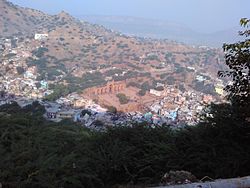Ajmer
| Ajmer अजमेर |
||
|---|---|---|
|
|
||
| State : |
|
|
| State : | Rajasthan | |
| District : | Ajmer | |
| Location : | 26 ° 27 ' N , 74 ° 38' E | |
| Height : | 481 m | |
| Area : | 8.48 km² | |
| Residents : | 542,321 (2011) | |
| Population density : | 63,953 inhabitants / km² | |
| Website : | Ajmer | |
| Ajmer - the townscape with the Adhai-din-ka-Jhonpra mosque | ||
Ajmer ( Hindi : अजमेर , Ajmer ) is a large city ( Municipal Corporation ) with about 540,000 inhabitants in the Indian state of Rajasthan . It is the administrative seat of the district of the same name . Ajmer is of particular importance as a holy place for Muslims , as the tomb of Khwaja Muin-ud-din Chishti , a Sufi who is revered as a saint , is located here.
location
Ajmer is located in a valley basin of the Aravalli Mountains in central Rajasthan , about 130 km southwest of the capital Jaipur, at an altitude of about 480 m . To the west, the city roughly marks the border with the Thar Desert . Approx. 15 km to the northwest is the holy city of Pushkar .
climate
The climate is warm to hot; Rain actually only falls in the summer monsoon months .
The climate crisis has led to a drastic shortage of drinking water in large parts of India . This is particularly noticeable in Ajmer. The city is one of those 21 major Indian cities whose groundwater reserves will be completely depleted in 2020 according to calculations by the government agency NITI Aayog.
population
Official population statistics have only been kept and published since 1991.
| year | 1991 | 2001 | 2011 |
| Residents | 402,700 | 485,575 | 542,321 |
A good 83.5% of the population are Hindus , a good 11.5% are Muslim , around 2.5% are Jains and a good 1% are Christians ; Members of other religions such as Sikhs , Buddhists etc. hardly play a role. As is common in northern India, the male population is around 5% higher than the female.
economy
In the area around Ajmer there is agriculture and cattle breeding - partly still for self-sufficiency. Officials, craftsmen, traders and service providers of all kinds have settled in the city. The pilgrimage also brings a lot of income.
history
Ajmer was founded in the late 10th century by the Chauhan -Raja Ajay. In 1019 Mahmud of Ghazni conquered and devastated large parts of northern India. Because of its strategic location, the city was conquered in 1193 by Mohammed of Ghori or his general Qutb ud-Din Aibak , who later founded the Sultanate of Delhi ; In the process, many Hindu and Jain temples were destroyed, the columns or pillars of which were reused as spoils in the construction of the Adhai-din-ka-Jhonpra mosque . In 1559 the city fell to the Mughal ruler Akbar I and for a long time remained an important place for the Mughals in Rajasthan, which is still dominated by Hinduism . After the death of the last great Mughal ruler Aurangzeb, the Marathas tried to establish themselves in the north of India; Ajmer fell into her hands in 1770. In 1818 Ajmer was one of the few places in Rajputana to come under direct British control; most of the others remained at least nominally independent princely states . On November 1, 1956, the Ajmer-Merwara Province came to the state of Rajasthan .
Attractions
- The Taragarh fort dates back to the Chauhan period; however, it was later changed repeatedly.
- The Adhai-din-ka-Jhonpra Mosque is one of the oldest mosques in India.
- The tomb of Sufi Khwaja Muin-ud-din Chishti ( Dargah Sharif ) is one of the holiest Muslim sites in Northern India.
- The Akbar Palace was built in 1570 by the Indian mogul Akbar I for his stays in the city and for his son Jahangir . The heavily fortified palace has served as a museum since 1908.
- The Badshahi Haveli is a residential and warehouse from Akbar's time.
- The interior of the Nasiyan Jain temple (also called the red temple ) is richly decorated; Particularly noteworthy is the model of a “Heavenly Palace” covered with gold leaf.
- The Ana Sagar is an artificial lake with the Khobra Behroon temple on the south bank .
- The Maya College is an imposing colonial building.
- Surroundings
- A trip to the town of Pushkar, 15 km away, is worthwhile .
- About 12 km east of the city are the complex of the Nareli Jain Temples .
Personalities
- Basu Chatterjee , film director and screenwriter
- Manvendra Singh Gohil , Prince of the Hindu Princely Family of Rajpipla
See also
Web links
- Ajmer, sights (Wikipedia, English)
- Ajmer, attractions - Photos and information (English)
- Ajmer, Badshahi-Haveli - photos + brief information ( ASI , English)
Individual evidence
- ^ Ajmer - Census 2011
- ↑ Ajmer - climate tables
- ↑ Jessie Yeung, Swati Gupta, Michael Guy: India has just five years to solve its water crisis, experts fear. Otherwise hundreds of millions of lives will be in danger. In: CNN. July 4, 2019, accessed on July 10, 2019 .
- ^ Ajmer - City Population 1991-2011
- ^ Ajmer - Census 2011



